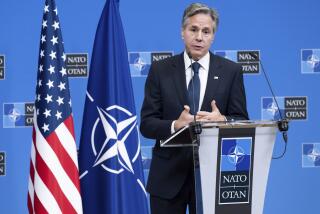Weighing the Risks, Benefits of Spy Flights Off China
- Share via
WASHINGTON — When senior U.S. military commanders for Europe, Latin America and Asia went before Congress recently to describe the dangers they faced, one thread ran through all the testimony: They needed more ISR--more intelligence, surveillance and reconnaissance.
In short, more of exactly what the Navy EP-3 spy plane was engaged in when it collided with a Chinese fighter April 1 and touched off the first national security challenge of George W. Bush’s presidency.
Especially in the post-Cold War era of tight defense budgets and more diverse threats, “you need a very robust ISR capability to warn you in case somebody makes a mistake and pokes his head over the parapet,” Dan Smith of the Center for Defense Information said here Thursday.
When it comes to China, however, some defense experts say the frequency and aggressiveness of the EP-3 flights and similar programs are creating risks far out of proportion to the benefits.
And although Defense Secretary Donald H. Rumsfeld insists that other countries similarly conduct spy flights, none of their efforts come close to matching the scale or intensity achieved by the world’s only remaining superpower.
Russia, some specialists say, can no longer afford even the limited spy missions it once flew along the East Coast of the United States. And China, which cannot begin to match the sophisticated gear in U.S. reconnaissance planes, must depend in part on slow, clumsy fishing boats to gather electronic intelligence.
Does the U.S. need to sustain its EP-3 flights off China’s coast? Or can it scale back the missions in the interest of reducing tension? Those questions are likely to underlie much of the discussion when officials of the two governments sit down Wednesday to discuss the fallout from the 11-day standoff that ended Thursday when China released the spy plane’s 24-member crew.
Officially, the U.S. position is that the only issue on the table will be how to make continued flights safer. “Reconnaissance flights are a part of a comprehensive national security strategy that helps maintain peace and stability in our world,” President Bush said Thursday.
Critics of the program argue that close-contact intelligence gathering could be moderated without reducing security or losing any valuable information. Some suggest that eventually, after the current controversy fades, Washington may quietly take such action.
“All information has some value. The question is, what are the risks and benefits,” said Lawrence Korb, vice president of the Council on Foreign Relations in New York. “Right now, we don’t want to look like we’re giving in to the Chinese, but eventually somebody may sit back” and calculate the costs and benefits.
The EP-3, an aging turboprop version of a commercial airliner, flies close to the coast of a target country and uses advanced electronic gear to collect information about communications, command and control systems, and other defense data.
During the Cold War, such missions gathered information on how Soviet fighter planes responded to intruders and communicated with one another and their bases. The data helped the U.S. develop countermeasures.
Today, critics of the EP-3 and some related programs contend that the same information can be gathered in less provocative ways. Satellites and ground-based listening posts in South Korea and Japan, as well as newer surveillance planes that can gather information from farther offshore, can do the job with less risk of accidents or confrontations, they say.
Moreover, skeptics question the need for keeping such a close watch on China. In this view, it will be decades, if ever, before China can mount a credible military threat against the U.S. And the threat to Taiwan, which China considers a renegade province, can be monitored and countered with other technologies.
“These are dangerous missions, and this isn’t the Cold War,” said James Bamford, a specialist in electronic intelligence-gathering. “To some degree, I think people are looking for something to do with resources left over from the Cold War.
“Everybody’s got to have an enemy. Everybody’s got to have a mission. And China’s the best game in town right now,” said Bamford, whose forthcoming book, “Body of Secrets,” deals with U.S. intelligence operations.
That assessment is directly challenged by defenders of the EP-3 and similar programs.
“The planes give us something on the ground and in real time that the satellites can’t always give us,” according to Gerrit Gong of the Center for Strategic and International Studies in Washington.
Gong and the Center for Defense Information’s Smith see the flights and the satellites as parts of a mutually reinforcing package. Satellites can spot new or unusual activity, but because they pass over a location at a predictable time, concealment or other countermeasures can be taken.
Aircraft can fly unscheduled missions to catch the intelligence target unprotected, Smith said.
And to Frank Gaffney of the Center for Security Policy, critics of the EP-3 simply underestimate the danger that China poses to Taiwan and the United States.
“When we’re dealing with a country that is working assiduously to keep us from knowing what it is doing, you need to bring all the collection assets you have to bear,” Gaffney said, noting that China operates a large electronic intelligence-gathering facility in Cuba in conjunction with the Russians and Cubans.
More to Read
Sign up for Essential California
The most important California stories and recommendations in your inbox every morning.
You may occasionally receive promotional content from the Los Angeles Times.













